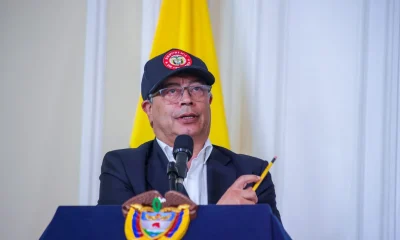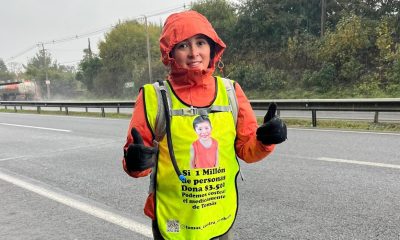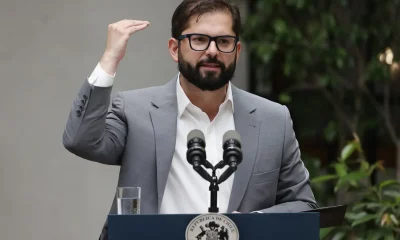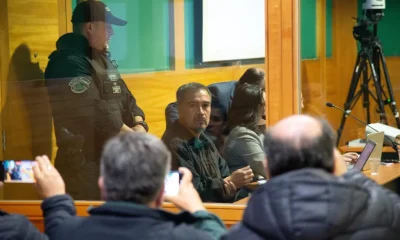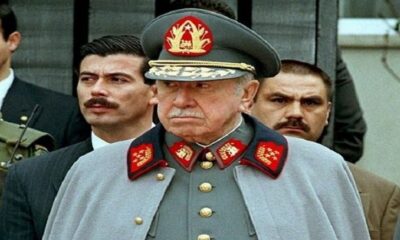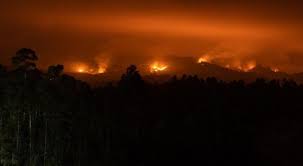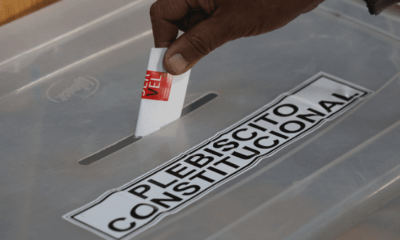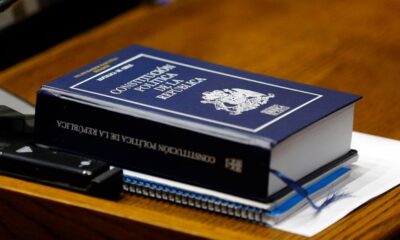International
Chilean mother travels 1,300 kilometers on foot to try to save her son with dystrophy

In the city of Ancud, one of the most important of the Chiloe archipelago, in the south of Chile, there is no hospital, so if one of its about 165,000 inhabitants gets sick, he must take the ferry and travel about 50 kilometers to reach the neighboring city of Puerto Montt, the nearest place.
Camila Gómez, a young mother, decided to take a trip but this time to walk to the Palacio de la Moneda, in Santiago de Chile, more than 1,300 kilometers from her home, to raise funds and make visible the drama of her son Tomás, who suffers from Duchenne muscular dystrophy, one of the so-called “rare diseases”, which almost no one worries and no one finances.
Its main objective is to help collect the nearly four million dollars that costs a vital treatment that does not exist in Chile – it must be imported from the United States – and that would help stop the progression of the child’s ailment, barely five years old.
“Tomás has Duchenne muscular dystrophy in a neuromuscular degenerative disease that gradually weakens the muscles, the respiratory system and the heart, which leads to premature death,” he explains in one of the highs of his journey.
“In Chile there is no type of treatment for this disease, but in the United States there are several treatment options, there are three and here they told me that it was not possible to cover a medicine that is abroad. And it motivated me to do this walk, this physical effort,” he adds.
Gómez regrets that no one, neither the precarious public service nor the greedy private insurance, has offered him an exit in the country, although his son “does have options abroad.
“That’s why we decided to walk, to make the disease visible and take it very particularly to collect the 3.9 million dollars that the drug that is administered for the only time in a lifetime costs. So far (its administration) is approved until the age of four and five. Tomás is five and a half years old. So we are against time,” she urges in anguish.
Even so, hope has not been erased from his face and sometimes, especially when asked about solidarity, he outlines a smile of love and trust.
“We are all aware of the great health deficit, that Chile is a country very backward in health, unlike other more developed countries and we are all aware of that. So people have empathized, supported and contributed to the campaign,” he says.
Along with this mother, who left Ancud on April 28, her husband and father of Tomás, Alex Ross, a friend Álvaro Neira and Marco Reyes, president of the Duchenne Families corporation in Chile, who has two teenage children with the same disease and who proposed the Ross Gómez family to the odyssey.
“I am the logistical support for Camila and Marco who have been walking from Chiloé. I assist them on the way, usually with a change of clothes, food, food, I manage the lodging,” explains Alex.
“(Camila) Walk through Tomás, because we are against time, but he also does it so that no mom has to do it,” he says.
Camila’s third objective is to be able to speak in person with the President of the Republic, Gabriel Boric, to urge him to promote a bill to Congress that allows improving the coverage of rare diseases in the country, and medical assistance in rural areas, abandoned by the state in a country where the privatization of health care prevails.
Neira joined the walk because he was moved by Tomás’ suffering but also because he is worried that “in Chile we do not have the means, a clinic where we can have these medicines, that we have to go to this.”
Tomás was diagnosed in March 2023 with Duchenne’s syndrome, the most common but also most severe form of this type of muscular dystrophy that is triggered by a defective gene that affects dystrophin, a protein that helps keep the body’s cells intact.
It causes problems when walking and running, fatigue, learning difficulties and heart and respiratory deficiencies, and those who suffer from it usually have a life expectancy of between 20 or 30 years in difficult conditions.
With more than 700 kilometers of love in her terrified legs, this mother hopes to arrive in the Chilean capital at the end of this month of May from Chiloe, where there is a movement so that the spending on a bridge that they believe is unnecessary, is dedicated to the construction of a perentory hospital
International
U.S. and Mexico Reach Deal to Address Water Deficit Under 1944 Treaty

The United States and Mexico have reached an agreement to comply with current water obligations affecting U.S. farmers and ranchers and for Mexico to cover its water deficit to Texas under the 1944 Water Treaty, the U.S. Department of Agriculture said in a statement.
The department уточified that the agreement applies to both the current cycle and the water deficit from the previous cycle.
On Monday, U.S. President Donald Trump accused Mexico of failing to comply with the water-sharing treaty between the two countries, which requires the United States to deliver 1.85 billion cubic meters of water from the Colorado River, while Mexico must supply 432 million cubic meters from the Rio Grande.
Mexico is behind on its commitments. According to Washington, the country has accumulated a deficit of more than one billion cubic meters of water over the past five years.
“This violation is severely harming our beautiful crops and our livestock in Texas,” Trump wrote on Monday.
The Department of Agriculture said on Friday that Mexico had agreed to supply 250 million cubic meters of water starting next week and to work toward closing the shortfall.
Agriculture Secretary Brooke Rollins, quoted in the statement, said Mexico delivered more water in a single year than it had over the previous four years combined.
Trump has said that if Mexico continues to fall short of its obligations, the United States reserves the right to impose 5% tariffs on imported Mexican products.
Mexico’s Deputy Foreign Minister for North America, Roberto Velasco, said that a severe drought in 2022 and 2023prevented the country from meeting its commitments.
International
Several people shot in attack on Brown University campus

Several people were shot on Saturday in an attack on the campus of Brown University, in the northeastern United States, local police reported.
“Shelter in place and avoid the area until further notice,” the Providence Police Department urged in a post on X. Brown University is located in Providence, the capital of the state of Rhode Island.
U.S. President Donald Trump said on his social media platform Truth Social that he had been briefed on the situation and that the FBI was on the scene.
At 5:52 p.m. local time (11:52 p.m. GMT), Brown University said the situation was still “ongoing” and instructed students to remain sheltered until further notice.
After initially stating that the suspect had been taken into custody, Trump later posted a second message clarifying that local police had walked back that information. “The suspect has NOT been apprehended,” the U.S. president said.
International
Colombia says it would not reject Maduro asylum request as regional tensions escalate

The Colombian government stated on Thursday that it would have no reason to reject a potential asylum request from Venezuelan President Nicolás Maduro should he leave office, as regional tensions persist over the deployment of U.S. military forces in the Caribbean since August.
“In the current climate of tension, negotiations are necessary, and if the United States demands a transition or political change, that is something to be assessed. If such a transition results in him (Maduro) needing to live elsewhere or seek protection, Colombia would have no reason to deny it,” said Colombian Foreign Minister Rosa Villavicencio in an interview with Caracol Radio.
However, Villavicencio noted that it is unlikely Maduro would choose Colombia as a refuge. “I believe he would opt for someplace more distant and calmer,” she added.
Colombian President Gustavo Petro also commented on Venezuela’s situation on Wednesday, arguing that the country needs a “democratic revolution” rather than “inefficient repression.” His remarks followed the recent detention and passport cancellation of Cardinal Baltazar Porras at the Caracas airport.
“The Maduro government must understand that responding to external aggression requires more than military preparations; it requires a democratic revolution. A country is defended with more democracy, not more inefficient repression,” Petro wrote on X (formerly Twitter), in a rare public criticism of the Venezuelan leader.
Petro also called for a general amnesty for political opponents and reiterated his call for forming a broad transitional government to address Venezuela’s prolonged crisis.
Since September, U.S. military forces have destroyed more than 20 vessels allegedly carrying drugs in Caribbean and Pacific waters near Venezuela and Colombia, resulting in over 80 deaths.
U.S. President Donald Trump has repeatedly warned that attacks “inside Venezuela” will begin “soon,” while Maduro has urged Venezuelans to prepare for what he describes as an impending external aggression.
-

 International4 days ago
International4 days agoMexico City prepares for 13 million pilgrims at Basilica of Guadalupe
-

 International3 days ago
International3 days agoWashington declares State of Emergency as atmospheric river brings severe flooding
-

 International3 days ago
International3 days agoU.S. to require five-year social media history from tourists under Visa Waiver Program
-

 Central America4 days ago
Central America4 days agoHonduras’ electoral chief reports ongoing technical issues but says results remain intact
-

 Central America4 days ago
Central America4 days agoU.S. accuses Ortega regime of systematic human rights abuses in Nicaragua
-

 Central America4 days ago
Central America4 days agoU.S. finds no evidence of fraud in Honduras election despite delays
-

 International2 days ago
International2 days agoCuba battles out-of-control dengue and chikungunya epidemic as death toll rises to 44
-

 Central America3 days ago
Central America3 days agoOAS and EU urge honduran political actors to respect vote results and avoid unrest
-

 Central America2 days ago
Central America2 days agoHonduras election crisis deepens as CNE president denounces intimidation attempts
-

 International2 days ago
International2 days agoColombia says it would not reject Maduro asylum request as regional tensions escalate
-

 International20 hours ago
International20 hours agoSeveral people shot in attack on Brown University campus
-

 International2 days ago
International2 days agoEcuador on track for record violence as homicides hit highest level in Latin America again
-

 International3 days ago
International3 days agoSix ecuadorian soldiers jailed pending trial for alleged extrajudicial execution
-

 International17 hours ago
International17 hours agoU.S. and Mexico Reach Deal to Address Water Deficit Under 1944 Treaty

























